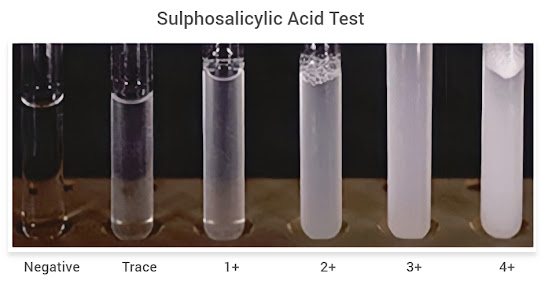Sulphosalicylic Acid Test for Proteinuria: Principle and Procedure
Most plasma proteins are too large to pass through the glomeruli of the kidney. The small amount of protein which does filter through is normally reabsorbed back into the blood by the kidney tubules. Only trace amounts of protein (less than 150 mg per 24 h) can therefore be found in normal urine. These proteins include Tamm-horsfall protein (Maximum-40%), Albumin (20%), Immunoglobulins, Hormones, Enzymes and Mucopolysaccharides.
When more than trace amounts of protein are found in urine, this is termed proteinuria. Detection of proteinuria is an important indicator of renal disease because protein has a very low maximal tubular rate of reabsorption. The following methods are used to test for proteinuria:
- Qualitative Tests:
Heat and acetic acid test
Sulphosalicyclic acid test
Hellers nitric acid test - Quantitative Tests:
Esbach’s method
Aufrecht’s method - Other tests:
Protein reagent strip test
Biuret test
Urine protein electrophoresis
Sulphosalicylic Acid Test
Principle
Proteins are precipitated by 5-sulphosalicylic acid. Any resulting turbidity will give an estimation of the amount of protein present in the urine which can be subjectively quantitated visually or more precisely quantitated using photometry. Cells and casts in the urine must be removed by centrifuging before carrying out the test. The test can detect albumin, hemoglobin, myoglobin, and Bence Jones proteins.
Requirements
- Specimen:
Random urine - Apparatus:
Centrifuge, general purpose
Graduated pipettes/micropipettes
Measuring Cylinder
Test Tubes
pH paper/ pH meter - Reagents:
5-sulphosalicylic acid solution-3%
Glacial acetic acid-10%
Procedure
- Check the pH of a portion of urine, if it is alkaline or neutral, add 10% acetic acid solution, drop by drop, until it is just acidic (about pH 6).
- If the urine is cloudy, filter or centrifuge the urine (5 minutes, 2000-3000 rpm).
- Take 2ml clear urine in a test tube.
- Add 2 ml 5-sulphosalicylic acid solution and mix. Do not shake. Examine for turbidity against a dark background.
Result and Interpretation
Grade the turbidity as follows:
Negative : No cloudiness
Trace: Faint turbidity.
1+ : definite turbidity
2+ : Heavy turbidity but no flocculation
3+ : Heavy turbidity with light flocculation.
4+ : Heavy turbidity with heavy flocculation.
Note:
Normal urine doesn’t contain detectable protein by this method. A false positive result may be obtained if the patient is receiving tolbutamide, penicillin and some other drugs. High concentration of urates in the urine may cause a false positive result due to precipitation of urate in an acidic urine.
References
- World Health Organization, 1986. Methods recommended for essential clinical chemical and haematological tests for intermediate hospital laboratories/Working Group on Assessment of Clinical Technologies. In Methods recommended for essential clinical chemical and haematological tests for intermediate hospital laboratories/Working Group on Assessment of Clinical Technologies.
- Ridley J.W. (2018) Procedures for Complete Urinalysis/Confirmation Testing. In: Fundamentals of the Study of Urine and Body Fluids. Springer, Cham. https://doi.org/10.1007/978-3-319-78417-5_10
- Cheesbrough, M., 1981. Medical laboratory manual for tropical countries (Vol. 1). M. Cheesbrough, 14 Bevills Close, Doddington, Cambridgeshire, PE15 OTT..


No comments:
Post a Comment